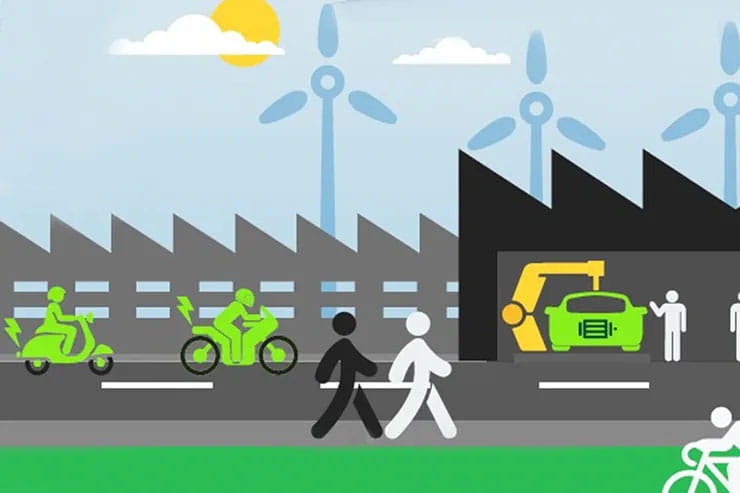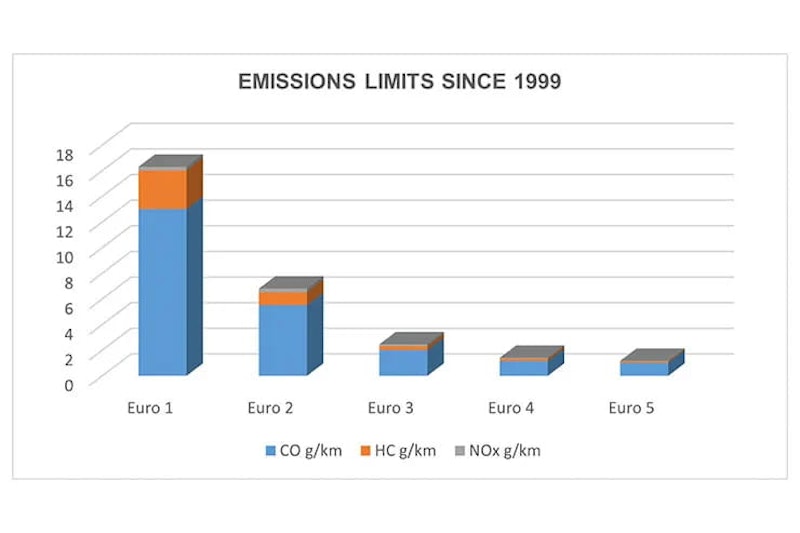New car emissions limits hint at future for bikes
By Ben Purvis
Motorcycle Journalist
14.11.2022
The European Commission has released its proposals for the ‘Euro 7’ emissions limits that will be the last stage of cuts made to combustion-engined four-wheelers before a total ban on all non-zero emissions cars in 2035. Since current motorcycle emissions limits are a carbon-copy of the car standards it’s likely that bikes will also be expected to hit the new targets – albeit at a later date.
At the moment the ‘Euro 6’ limits for cars are essentially aligned with the ‘Euro 5’ standards that new bikes have to meet. That means motorcycle ‘Euro 6’ – whenever it arrives – is likely to take the new ‘Euro 7’ standards for cars as a template. The Euro 7 car rules are due to be phased in from 1st July 2025, but there’s currently still no schedule for the introduction of motorcycle Euro 6 or any firm proposals as to what the motorcycle standards will be.
As the last step towards cleaner combustion engines before that technology is consigned to the history books, with zero tailpipe emissions mandatory for new cars in Europe from 2035, the changes for Euro 7 aren’t as radical as some earlier emissions limits. Essentially, the rules take the current limits for tailpipe emissions for petrol and diesel cars and standardise them across both fuel types – picking the lower emission limit in every area where there’s currently a difference. For petrol engines, that means there will be no change in hydrocarbon (HC) or NOx emission limits, but carbon monoxide (CO) limits will be halved from 1g per km to 0.5g per km.
The Euro 7 rules will also introduce new testing methods intended to replicate short trips and different temperatures, as well as introducing compliance checks to make sure vehicles still meet the limits until 200,000km and 10 years, double the longevity of the Euro 6 limits.
At the moment, the standards for current, Euro 5 motorcycles essentially match the Euro 6 limits for cars in terms of CO, HC, NOx and particulate emissions, so it’s not a huge leap to suggest that when Euro 6 for bikes is considered, the same halving of CO limits may be on the agenda.
However, it’s likely to take several years for Euro 6 motorcycle standards to be hammered out. The next step in motorcycle emissions restrictions will be ‘Euro 5+’ – due to be mandatory on newly type-approved bikes in 2024 and carry-over models in 2025 – which introduces OBD-II emissions monitoring. That was postponed from the initial introduction of Euro 5 due to problems developing misfire detection sensors that worked well enough in the relatively harsh environment of a motorcycle engine. That means motorcycle Euro 6 isn’t likely to arrive until towards the end of this decade.
The introduction of Euro 7 for cars has already got manufacturers up in arms. Faced with an internal combustion engine ban in 2035, there’s an argument that the R&D investment needed to develop cleaner combustion engines would be better spent on zero-emissions technology. Since it’s looking increasingly likely that new motorcycles will also have to be zero emission vehicles in 2035 – something that the UK government is already working towards – bike makers are likely to be equally unwilling to spend money on developing new ICE technology.
While a row is already brewing over the impact that Euro 7 rules will have on combustion engines in cars, the proposed standards include elements that go far beyond the powertrain by bringing limits on emissions that don’t come from the engines or their fuel at all.
It’s becoming increasingly clear that particulates thrown out as tyres and brakes wear are a health hazard, particularly to those living near roads, and Euro 7 rules intend to put restrictions on these emissions as well. While the actual limits on these emissions have yet to be established – research is due to be completed by the end of 2024 to establish them – their introduction is likely to mean the compounds and construction of tyres and brake pads will have to change. Work is even underway on filtering systems for brakes to capture brake dust rather than release it into the air.
All of these limits are also sure to filter though to bikes. By 2050, the European Commission expects brake and tyre emissions to account for more than 90% of the particulates from road transport, and they remain an issue even once zero emission (electric) powertrains are introduced.
In fact, the problem may be worsened, as electric cars and motorcycles are generally heavier than their combustion-engined equivalents – increasing the strain and wear on tyres in the process. Energy recovery systems for electric vehicles mean that they tend to wear their brakes less than ICE-powered ones, though.
It’s clearer than ever that despite the latest cars and motorcycles being the cleanest that there’s ever been, their emission will remain a target for lawmakers (and, inevitably, taxation) on the run up to, and even beyond, the wholesale transition to electric power.
Share on social media:

